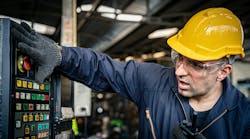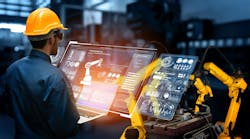As robots become more advanced, the Association for Advancing Automation, which includes what was once the Robot Industries Association (RIA), has encouraged more decisive risks analysis for safety. Many machine builders go straight to RIA 15.06 as a standard because its more comprehensive than having two standards, one for robotic machines and one for non-robotic machines. This is a go-to for motion-control applications. However, it does not stand alone. Why? In any safety configuration, one must consider how the machine is going to stop and in which instances.
National Fire Protection Association (NFPA) 79 is an industrial machine safety regulation and defines stops in categories. Category 0 is an uncontrolled stop by immediate removal of power to the machine actuators. This requires non-retentive relays. A reset to initial state is required. Category 1 is a controlled stop with power to the machine actuators to achieve a stop and removed power when the stop is achieved. Category 2 is a controlled stop with power left available to the machine actuators.
As a machine builder, it might be difficult to discern the differences as to when one might do a full stop, controlled stop, stop with power ready. What is a good reference to follow?
Emergency stops or conditions are the “darn it” buttons and require quick stops. This is a Category 1 type stop. Category 2 would be an instance when a stop requires power to remain on a circuit. Hydraulic oil may need to keep circulating for an auxiliary power unit (APU) response, even if a machine is stopped. E-stops are not Category 2 stops, but a machine stop can be Category 2.
Category 1, quick stops after short amount of time, are used for high inertia machines where an immediate stop would harm people or machine, and the safe way to stop is to allow a time to slow down before removing power. Removing power from the machine in a hard stop, would require a timed slow down and then removal of power. This is discerned by the application. Things to consider are time to stop, damage in not waiting for a controlled stop, risks between controlled stop and depowered stop regarding people.
In automated assembly lines, a Category 1 stop is crucial for safely halting operations. For instance, if a sensor detects an obstruction or a malfunction, the system initiates a controlled deceleration of the conveyor belts and robotic arms before cutting off power.
Computer numerical control (CNC) machines, which are used for precise cutting, milling and drilling, often employ Category 1 stops. When an emergency stop is activated, the machine decelerates in a controlled manner to avoid damaging the workpiece or the cutting tool, and then power is cut off.
Automated guided vehicles (AGVs) used in warehouses and manufacturing plants rely on Category 1 stops to ensure safety. If an obstacle is detected in the vehicle’s path, the AGV will decelerate smoothly before stopping completely, reducing the risk of collisions and damage.
In packaging lines, Category 1 stops are used to prevent damage to both the machinery and the products being packaged. For example, if a jam is detected, the machine will decelerate before stopping, allowing operators to clear the jam safely.
High-speed printing presses use Category 1 stops to avoid damage to the printing plates and paper. When an emergency stop is triggered, the press decelerates in a controlled manner before stopping, ensuring that the print quality is maintained and the equipment is protected.
Cold mills hold high tension with dangerous metal sheets. When a Category 1 stop is made the tension can be decreased on a set ramp to allow safe maneuvering of metal sheeting on a roll. This saves the material and the people. A hard depowered stop would leave tension on the sheet and risk a break and possible equipment damage.
Would a stop due to fire be a Category 1 stop? No. That is a Category 0 stop. Why? Fire hazard. Get out now.
Category 2 stops are like pushing the stop button in manual mode but keeping the power on because the drive should be ready for a “jog” function.
In conclusion, there are three types of category stops for machine builders: categories 0, 1 and 2. The most extreme is a hard-stop Category 0. The least extreme is a soft stop, which is Category 2, and Category 2 may not be an emergency stop.
Understanding what the machine does on a stop and how it should operate is critical for machine functionality. Why? Safety is not just about human safety but machine usability. The risk assessment should define the type of stop, the reason and what power is cut off for each stop. For Category 2 stops, the timing until the power is shut off should be known so that it can be briefed to operations.
Sponsored Recommendations
Sponsored Recommendations





